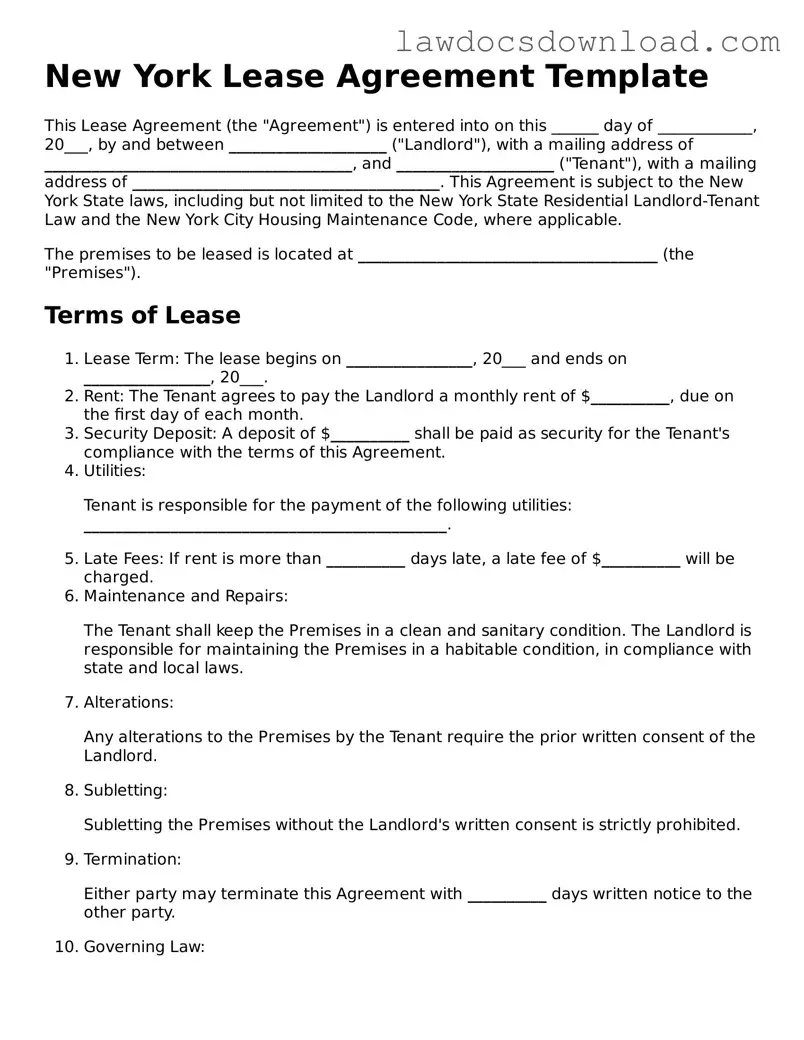The New York Lease Agreement form shares similarities with a Rental Application form. Both documents are foundational to the leasing process, where the Rental Application is the precursor to the Lease Agreement. In the Rental Application, prospective tenants provide personal and financial information, which landlords use to screen and select a tenant. This step precedes the Lease Agreement, which legally formalizes the rental arrangement, specifying terms such as duration, rent amount, and responsibilities of each party. Thus, while they serve different stages of the tenant selection and agreement process, both are geared towards establishing a formal relationship between landlord and tenant.
Another document akin to the New York Lease Agreement is the Sublease Agreement. This document comes into play when an existing tenant wishes to rent out the leased premises to a third party. Like the Lease Agreement, a Sublease Agreement outlines terms including but not limited to the duration of the sublease, rent, and house rules. However, it operates under the umbrella of the original lease, making the original tenant essentially a 'sublandlord' but still responsible to the original landlord, thus creating a hierarchy of agreements rooted in the original Lease Agreement terms.
A Roommate Agreement also parallels the New York Lease Agreement in several ways, particularly in a shared housing scenario. This type of agreement is drafted among tenants sharing the same rental property and details the division of rent, utility payments, chores, and other responsibilities. While the Lease Agreement establishes the legal relationship between landlord and tenant, a Roommate Agreement solidifies the internal structure among tenants, ensuring a harmonious living situation. Both documents are pivotal for maintaining clarity and preventing disputes in their respective domains.
The Property Management Agreement is another document similar to the New York Lease Agreement, primarily from the landlord's perspective. Where the Lease Agreement is an agreement between landlord and tenant, the Property Management Agreement is between the landlord and a property manager or management company. This document outlines the responsibilities of the manager, such as advertising rentals, handling tenant concerns, maintaining the property, and collecting rent. Both agreements facilitate the smooth operation of renting out property, albeit focusing on different aspects of the rental process.
The Eviction Notice, while not a contract like the New York Lease Agreement, is a legally binding document that a landlord must provide to a tenant to initiate the eviction process for reasons such as non-payment of rent, violation of lease terms, or other lease breaches. Both documents are regulated by state laws and are critical to the landlord-tenant relationship's legal framework. The Lease Agreement sets the terms of the tenancy, and the Eviction Notice enforces these terms under the threat of legal action for non-compliance.
Lastly, a Lease Renewal Agreement has strong ties to the original New York Lease Agreement, acting as its direct sequel. This document extends the duration of the original lease, allowing the tenant to continue living in the property under agreed-upon terms, which may or may not be identical to the original lease. Both documents ensure the legal occupancy and terms of tenancy are clearly defined and agreed upon, but at different points in the tenant-landlord relationship, providing continuity or establishing new terms as needed.
